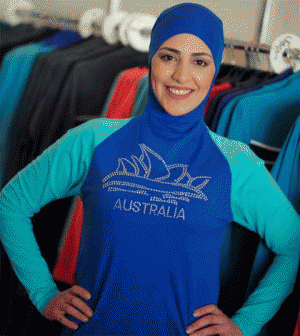- Finding Unshakable Power in a World That Wants to Pull Us ApartPosted 5 months ago
- What could a Donald Trump presidency mean for abortion rights?Posted 5 months ago
- Financial Empowerment: The Game-Changer for Women in Relationships and BeyondPosted 6 months ago
- Mental Health and Wellbeing Tips During and After PregnancyPosted 6 months ago
- Fall Renewal: Step outside your Comfort Zone & Experience Vibrant ChangePosted 6 months ago
- Women Entrepreneurs Need Support SystemsPosted 7 months ago
INTERVIEW - France has 'misunderstood' the burkini, Australian designer says

“The burkini was designed for freedom, flexibility and confidence. It was designed to integrate into society”
By Lin Taylor
The French authorities have misunderstood why the burkini was created and should not turn it into a symbol of division, the Australian designer of the swimsuit said on Wednesday.
The burkini swimsuit made international headlines after the mayors of Cannes, Villeneuve-Loubet and the Corsican seaside resort of Sisco banned it last week, arguing the burkini, which leaves only the face, hands and feet exposed, defies French laws on secularism.
“They have misunderstood what the burkini is all about,” said Aheda Zanetti, adding that anyone, no matter their religion, could wear it.
“I hope that they understand that it’s not something that symbolises anything – that anyone can wear it, that it’s not harming anything in any way.”
With the sun and surf an integral part of the Australian lifestyle, Zanetti designed the swimsuit in 2004 so Muslim women, who choose to wear a head covering like the hijab, could participate in water activities and other sports.
“The burkini was designed for freedom, flexibility and confidence. It was designed to integrate into Australian society,” she said in a phone interview with the Thomson Reuters Foundation from Sydney.
Zanetti said she is perplexed the burkini has attracted so much attention, given its normalcy in Australia.
“Look what’s happening in Syria or in Italy,” she said, referring to the ongoing Syrian conflict and an earthquake that killed more than 70 people in Italy on Wednesday.
“I don’t understand why a piece of fabric is taking over all of these really important issues?” Lebanese-born Zanetti said.
“Why do women have to be punished for wearing something that represents freedom, and health, fitness and enjoyment?”
The burkini debate is particularly sensitive in France, where the full face niqab and burqa veils were banned in 2010.
Tensions between communities have heightened following deadly attacks by Islamist militants.
Last month, a Tunisian killed 85 people when he drove a truck into crowds in Nice and a Roman Catholic priest had his throat cut in church by two French Muslims. And in November, 130 people were killed by bombings and shootings in Paris.
Zanetti, who has lived in Australia for more than 40 years, designed the burkini after watching her niece, who chose to wear a hijab, struggle to find lightweight clothes for her school netball games.
By using a hood to cover the head, rather than a burqa veil, Zanetti said the burkini had become an option for non-Muslim women.
The designer estimated that 40 percent of her sales come from non-Muslim women, with cancer survivors, body conscious mothers or women who want to protect their skin from the sun among the buyers.
(Reporting by Lin Taylor @linnytayls, Editing by Katie Nguyen.; Please credit the Thomson Reuters Foundation, the charitable arm of Thomson Reuters that covers humanitarian issues, conflicts, global land and property rights, modern slavery and human trafficking, women’s rights, and climate change. Visit http://news.trust.org to see more stories)






